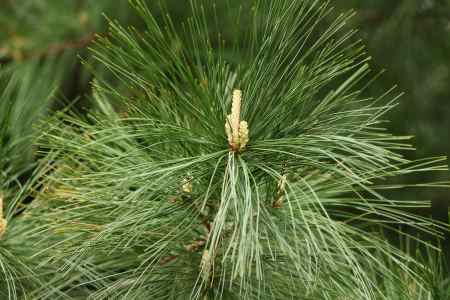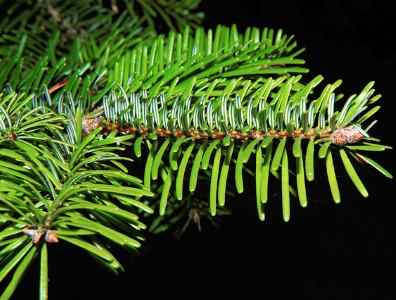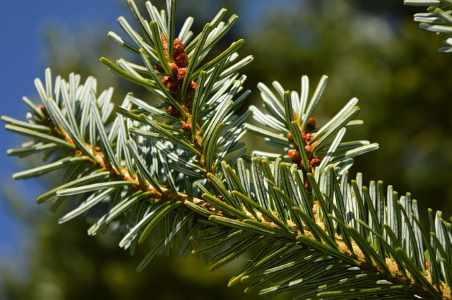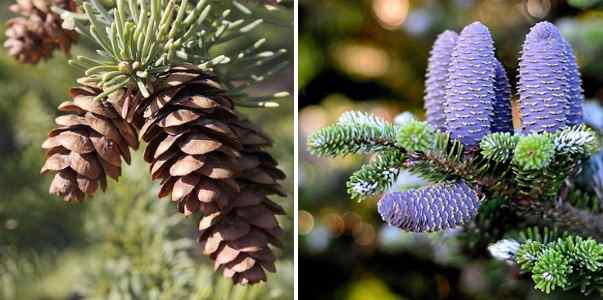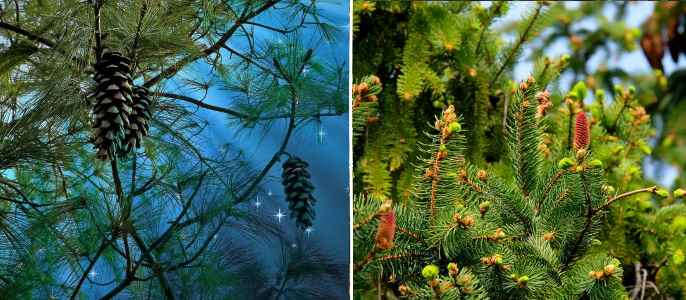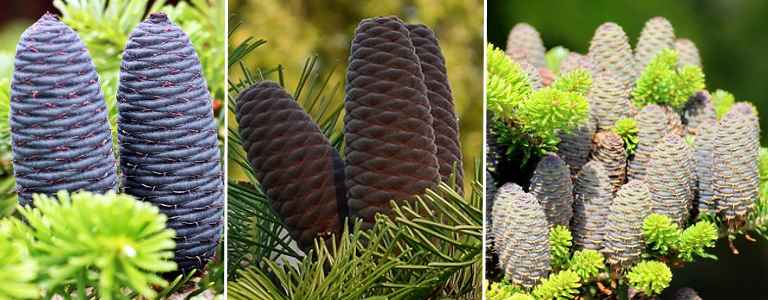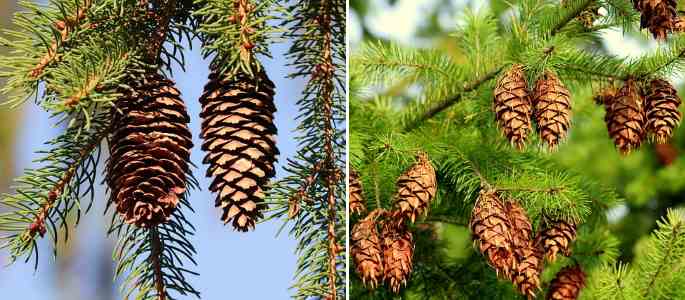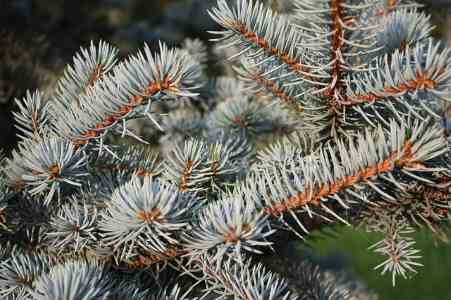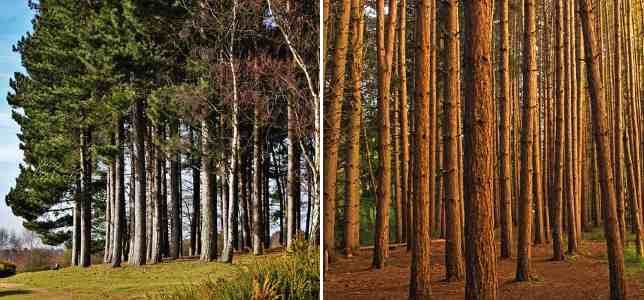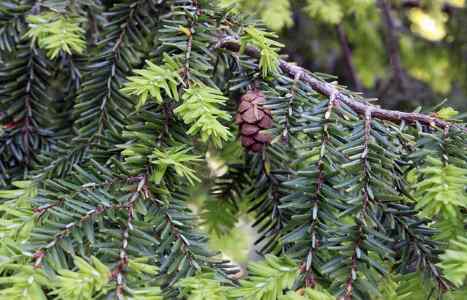Ultimate Conifer Identification Guide: Pine, Fir, and Spruce with Pictures, Charts, and Names
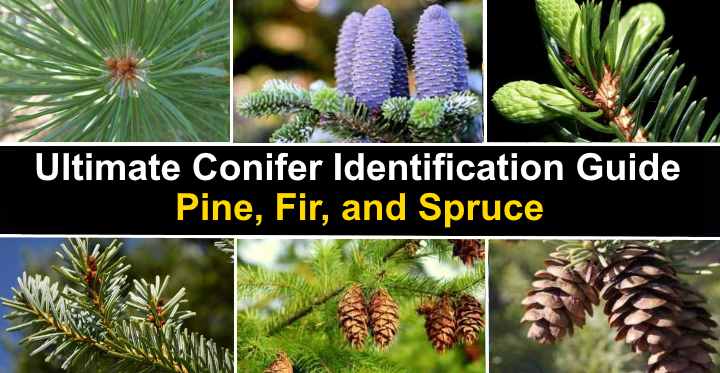
At first glance, many types of conifers may look the same and be hard to identify. One of the best ways to tell pine, spruce, and fir trees apart is by their needle leaves. You may also notice differences in these evergreen trees by looking at their cones, branches and bark. With a few facts about conifers, you will be able to easily identify the different species of these hardy trees.
Conifers are a type of woody plant that belong to the botanical division Pinophyta and class Pinopsida. Apart from firs, spruces, and pines, other trees belonging to the families of conifers include cedar, cypress, yew, and juniper trees. Most species of conifers are known for staying green all year, producing woody cones, and having leaves that are needle-like.
Conifers are also a fast-growing type of tree that grow in many countries in the Northern Hemisphere. Many conifer species are cold hardy and can withstand freezing conditions. Other types of pine and fir trees are better suited to warmer climates. Similar to deciduous trees, spruces, pines, and fir trees lose their needle-like leaves. However, this happens gradually, and due to this, conifers keep their foliage and green color all year long.
In this article, you will learn how to identify many types of conifers. Pictures, descriptions, and identifying features of pine trees, spruce trees, and fir trees will help with conifer identification.
Fir vs. Spruce vs. Pine: How to Tell Them Apart
The easiest way to tell a pine tree apart from a spruce or fir tree is by looking at their needles.
As a quick guide to identifying a species of conifer, take the twig and look closely at how the needles are attached. Needles on pine trees grow in clusters of 2, 3, or 5. If there are just single needles growing from the shoot or twig, this is probably a spruce or fir tree.
What about the difference between a fir and spruce tree? Again, needle types are the key to identification. Spruce needles have four sides and they roll easily between your fingers. Fir needles are flat and if they don’t roll easily, chances are it is a fir tree, not a pine or spruce.
Identifying Spruce, Pine or Fir Based on their Needles
Let’s look in more detail at how to identify the most popular types of conifers by examining their needles.
Pine Tree Identification by Needles (With Pictures)
The best way to identify pine trees (genus Pinus) is by looking at their needle-like leaves.
Pine needles grow in clusters on the branch which helps tell pines apart from other conifers. These clusters or bunches are called fascicles. Pine trees have 2 (red pines), 3 (yellow pines), or 5 (white pines) needles in each fascicle.
Very often, pine needle clusters are arranged spirally on the branch. You will notice the bundles of needles are held together on the branch with what looks like black tape wrapped around the base. This needle bundle is attached at a single point on the tree twigs.
Another feature of pine needles is that they tend to be longer than spruce or fir needle leaves. Some species of pine trees have needles that are up to 16” (40 cm) long. This makes them the longest leaves on any type of conifer.
When conifers such as pine and spruce drop their leaves, this creates a layer of needles called duff. As the leaves break down, they release nutrients that feed the trees and this adds to the evergreen forest’s ecosystem.
Fir Tree Identification (With Pictures)
The way to identify fir trees (genus Abies) by their needles is by looking at the shape of the needles and how soft they are.
Similar to needles on spruce trees, fir tree needles grow singularly from a single point on the branch. Looking at pictures of fir branches and needles, you will see they attach to the branch with something that looks like a suction cup.
You will also notice that fir tree needles are distinctive in that they are flat and have an almost squashed appearance. You will find that, unlike pine and spruce needles, fir tree needles won’t roll between your fingers.
Another way to distinguish fir needles from other conifers is by the 2 whitish lines on their underside. These silvery-white stomatal bands can give some fir trees a bluish, silvery appearance. This often contrasts with the deep green color of the upper side of fir tree foliage.
Some species of fir trees have needles growing from both sides of the twig and others grow like a comb.
Fir trees tend to retain their needles for a long time after cutting them down. For this reason, fir trees are among the most popular types of Christmas trees.
Spruce Identification (With Pictures)
The best way to identify spruce trees (genus Picea) is by their needle shape and the way they grow on the branch.
As with all species of conifers, spruces have needle-like leaves. Unlike firs, spruce needles have 4 sides so they are not flat. They are also attached to the twigs by a woody joint or peg. If there are no needles on spruce branches, you will find that they have a spiky or jaggy look, unlike smoother pine and fir branches.
Their quadrangle shape means spruce needles are easy to roll between your fingers. Because pine needles also roll easily, you can identify the type of conifers by needles’ growing habit. Spruces grow singularly from the branch whereas pine needles are in clusters.

Spruce needles grow singularly on the branch (unlike pine needles) and are round (unlike fir needles)
Identifying Spruce, Pine or Fir Based on their Cones and Branches
Conifer tree identification is also possible by looking at the cones and branches to spot some subtle differences. Conifer cones are made up of scales that grow out of a center stalk.
All conifers have 2 types of cones – pollen cones and seed cones. The male cones (pollen cones) are similar on all conifer species and are smaller than the female ones (seed cones). The seed cones are usually woody and brown and can be useful in the identification of conifer species.
Pine Tree Identification by Cones and Branches (With Pictures)
Pine cones (pinecones) can be large to small and are characterized by thick, hard woody scales. From all of the conifers, pine cones are inflexible and are the hardest. Pines also produce the largest cones from all the species of conifers.
Pine seed cones can be large to small and come in varying shapes. Some pine cones are oval-shaped like an egg, whereas other species of pine trees produce conical cones. One of the distinguishing features between pine cones and fir cones is that pine cones hang down from the branches.
Looking at pictures of pines, spruces, and firs, you will also notice that pine tree branches are less dense. If you compare the number of branches between the 3 types of conifers, you will also see that pines have fewer branches.
Another way to identify many kinds of pine trees from fir trees is that pine branches are usually upturned. However, some species of pines have long drooping branches that give the tree a slender skinny look.
Fir Tree Identification (With Pictures)
You can immediately identify fir trees from the way the cones grow on the branches. Firs are the only type of conifers where the cones grow upward rather than droop. Spruce and pine cones all hang off branches.
Looking at fir cones and pine cones side by side, you can spot the fir cones because they are generally cylindrical. Pine cones are usually oval or triangular-shaped. Even some pine cones that are long and conical differ from fir trees in the way they grow on the tree. Some fir cones can grow up to 10” (25 cm) and they resemble brown-colored candles sitting erect on branches.
Fir trees also produce some of the most colorful types of conifer cones. Mature cones have soft brown scales. However, before they reach this stage, they may be purple, white, green, or very dark blue.
Fir tree branches have a more downturned shape when compared to spruce or pine branches.
Spruce Identification (With Pictures)
Spruce cones hang down similar to how pine cones grow. The way to identify spruce trees by their cones is that they are much softer, flexible, and have thinner scales. If you take a long spruce cone in your hand, you will find that you can bend it, which is impossible to do with stiff pine cones.
Trying to tell spruce trees apart from pine trees just by branch growth is difficult. The identification key is branch density. Spruce trees have densely packed evergreen branches and pine trees have a sparser look to them.
Most pine and spruce conifer species tend to have upturned branches. This branch growth helps to distinguish them from conifers like firs as their branches are usually downward turned.
Because spruce needles grow from small woody pegs, spruce branches are rough and jaggy. This is in contrast to pine and fir branches that tend to be smooth.
Identifying Spruce, Pine or Fir Based on their Bark and Growth Habit
Other identification tips for conifers are to look closely at the type of bark and how the tree grows.
It can be difficult to differentiate between pine, fir, and spruce trees based solely on the bark. However, noting the type of cones, types of needles, and the bark color are all good for identifying purposes.
Pine Tree Identification Chart (With Pictures)
The bark growing on most pine trees is smooth and immature and gradually becomes orangey-red.
Depending on the species of pine, the bark can stay relatively smooth on mature trees. You may notice that this type of bark remains thin and has a flaking nature as it grows. However, many species of pines develop thick scaly bark that is orangey-brown to gray. In fact, it’s not unusual for some types of pine trees to have two-toned trunks that appear gray and red.
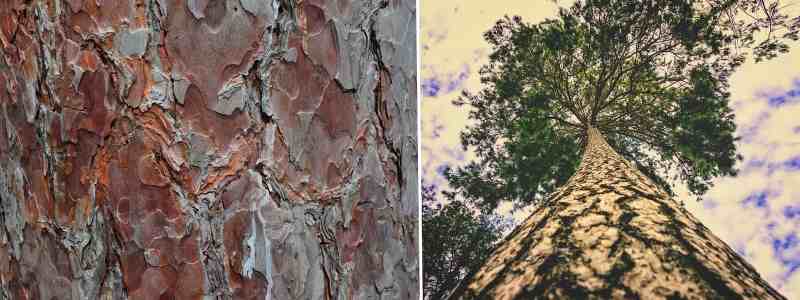
Some pine trees have gray and red bark that is relatively smooth (left) and others develop thick scaly bark
You will notice that most species of pine trees have an A-like shape or conical shape. There is usually space between the branches which means that pine forests aren’t as dark as spruce or fir forests. However, there are some exceptions. The foliage of some pine species grows to create a large wide canopy similar to an umbrella.
Many types of pine trees are also identified by the fact that most of the branches grow near the top of the tree.
Pine wood is also a high-quality softwood that is prized in the timber industry. Long straight tall pine trunks make for excellent lumber. Other pine trees are identified by their crooked appearance with irregularly growing trunks and branches.
Fir Tree Identification (With Pictures)
The bark on fir trees is generally smooth and gray when the tree is young. As the tree matures, the bark becomes thick and scaly with furrows or ridges running vertically. As a general identification rule, the bark on fir trees is generally more deeply furrowed than other types of conifers.
Fir trees, similar to spruces, are also identified by their pyramid conical shape. Many people describe this as the classic Christmas tree shape. Fir trees usually keep their A-shape as they grow from small fir trees into majestic pointed conifers.
Spruce Identification (With Pictures)
Most spruce trees have rough bark that is loose, furrowed and scaly. The patchy bark on most species of spruce is generally gray; however, some species have reddish-brown, gray-brown, or dark green-brown colors.
You may find it is easy to pick off pieces of bark from live spruce trees.
Spruce trees grow in a similar shape to fir trees and they are difficult to identify by shape alone. The perfect pyramid shape of spruce trees is one reason why these are popular Christmas trees. To tell the difference between spruces and firs, you need to feel the needles. Spruce trees have sharp spiky round needles and fir trees have flat soft needle leaves.
Spruce vs. Pine
The easiest way to tell the difference between spruce trees and pine trees apart is by their needles and cones.
Pine needles are relatively long, soft, and grow in clusters. Spruce needles are shorter and sharper and don’t grow in clusters.
Pine cones and spruce cones are different because pine cones are rigid whereas cones from spruces are soft and flexible.
Fir vs. Spruce
Fir and spruce conifers are similar in appearance and may be difficult to tell apart just by looking at pictures. If you see images of cones growing on conifers, firs trees are the ones where cones grow erect, not hang down.
The easiest way to tell a fir apart from a spruce is to feel the needles. The soft flat shape of fir leaves makes it impossible to roll between your fingers. This is unlike spruce needles that are rounded, stiff and sharp.
How to Identify Other Conifers
Apart from the 3 main types of conifers in this guide, there are some easy ways to identify other types of needled evergreens.
Yew (Taxus)
Yew trees have dark green glossy needle leaves that are soft and flattened with a lanceolate shape. Cones on yew trees are small and round and only contain a single seed. These evergreen conifers have bark that is reddish-brown with deep fissures that can become flaky.
Hemlock (Tsuga)
Hemlocks are a type of evergreen conifer that grow in a conical shape and have drooping or weeping branches. Hemlock needles are glossy green, short, and soft and are arranged spirally on the twigs. Most species of hemlocks grow cones that are egg-shaped and oval, however, some cones are also long and cylindrical.
Juniper (Juniperus)
The identification features of juniper evergreen conifers are short, sharp, prickly leaves growing on many species. Some juniper species also develop scale leaves as they mature. Another unique feature of juniper cones is that they are soft and fleshy with a look and feel of small blue berries. Junipers are also related to cedars, although they are not a true type of cedar.
Cedar (Cedrus)
True cedars are a type of coniferous tree with needle-like leaves that grow in spiral clusters and are bluish-green in color. Types of cedars are also known for their hard, fissured bark, barrel-shaped cones, and aromatic soft foliage that grows on short stems.
Cypress (Cupressus)
Cypress are types of evergreen trees or shrubs that have soft scale-like leaves that are flat like fir trees and give the plant a feathery feel. Like most conifers, cypress trees produce brown woody cones that are globule to oblong in shape.
Thuja (Thuja)
Thujas are related to cypress and cedar trees and grow in a conical shape with soft feathery scale leaves. These evergreen conifers have small soft cones, smooth gray bark, and thick, dense green foliage. Some species of thujas are also called cedars.
Related articles:


